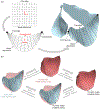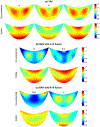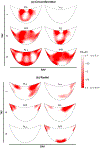Patient-Specific Quantification of Normal and Bicuspid Aortic Valve Leaflet Deformations from Clinically Derived Images
- PMID: 34993699
- PMCID: PMC9084616
- DOI: 10.1007/s10439-021-02882-0
Patient-Specific Quantification of Normal and Bicuspid Aortic Valve Leaflet Deformations from Clinically Derived Images
Abstract
The clinical benefit of patient-specific modeling of heart valve disease remains an unrealized goal, often a result of our limited understanding of the in vivo milieu. This is particularly true in assessing bicuspid aortic valve (BAV) disease, the most common cardiac congenital defect in humans, which leads to premature and severe aortic stenosis or insufficiency (AS/AI). However, assessment of BAV risk for AS/AI on a patient-specific basis is hampered by the substantial degree of anatomic and functional variations that remain largely unknown. The present study was undertaken to utilize a noninvasive computational pipeline ( https://doi.org/10.1002/cnm.3142 ) that directly yields local heart valve leaflet deformation information using patient-specific real-time three-dimensional echocardiographic imaging (rt-3DE) data. Imaging data was collected for patients with normal tricuspid aortic valve (TAV, [Formula: see text]) and those with BAV ([Formula: see text] with fused left and right coronary leaflets and [Formula: see text] with fused right and non-coronary leaflets), from which the medial surface of each leaflet was extracted. The resulting deformation analysis resulted in, for the first time, quantified differences between the in vivo functional deformations of the TAV and BAV leaflets. Our approach was able to capture the complex, heterogeneous surface deformation fields in both TAV and BAV leaflets. We were able to identify and quantify differences in stretch patterns between leaflet types, and found in particular that stretches experienced by BAV leaflets during closure differ from those of TAV leaflets in terms of both heterogeneity as well as overall magnitude. Deformation is a key parameter in the clinical assessment of valvular function, and serves as a direct means to determine regional variations in structure and function. This study is an essential step toward patient-specific assessment of BAV based on correlating leaflet deformation and AS/AI progression, as it provides a means for assessing patient-specific stretch patterns.
Keywords: Aortic valve; Computational modeling; Deformation; Echocardiography; Patient stratification.
© 2021. The Author(s) under exclusive licence to Biomedical Engineering Society.
Figures









References
-
- Balachandran K, Sucosky P, Jo H, and Yoganathan AP. Elevated cyclic stretch alters matrix remodeling in aortic valve cusps: implications for degenerative aortic valve disease. Am. J. Physiol.-Heart Circ. Physiol 296(3):H756–H764, 2009. - PubMed
MeSH terms
Grants and funding
LinkOut - more resources
Full Text Sources
Medical
Research Materials

